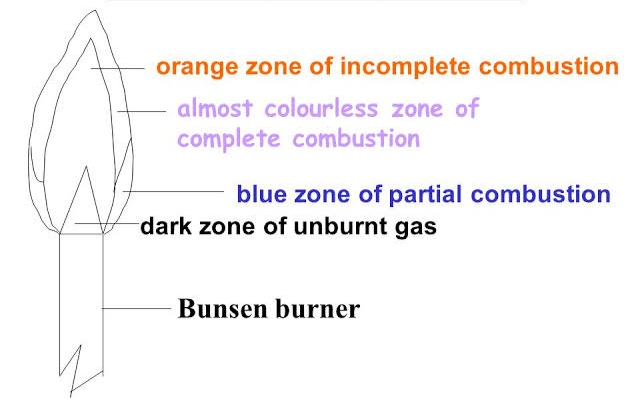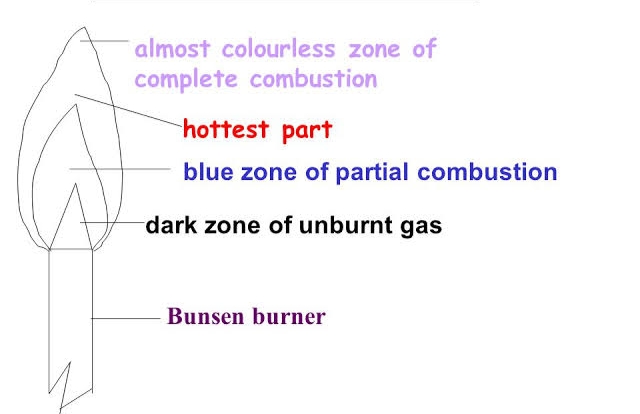A flame is a combination of burning gases giving out heat and light. The Bunsen burner produces two different types of flame:
- Luminous flame
- Non-luminous flame
The Bunsen burner consists of a metal tube on a base with a gas inlet at the lower end of the tube, which may have an adjusting valve; openings in the sides of the tube can be regulated by a collar to admit as much air as desired.
The mixture of air and gas (optimally about 1 part gas to 3 parts air) is forced by gas pressure to the top of the tube, where it is ignited with a match. It burns with a pale blue flame, the primary flame, seen as a small inner cone, and a secondary, almost colorless flame, seen as a larger, outer cone, which results when the remaining gas is completely oxidized by the surrounding air.
With too little air, the gas mixture will not burn completely and will form tiny carbon particles that are heated to glowing, making the flame luminous. With too much air, the gas mixture will burn completely producing a pale-blue flame, which is referred to as non-luminous.
A strike-back may occur sometimes when you use a Bunsen burner. It generally occurs when there is little gas and too much air entering the air-hole (air-hole is wide opened). Then, instead of burning at the top of the barrel, the gas burns at the jet. A green flame is seen at the top of the barrel as the gas burns at the jet. The collar will be hot and a loud sound will be heard. When a strike back occurs, turn on the gas tap immediately.
What Is a Luminous Flame?
A luminous flame occurs when the air hole of the Bunsen burner is open. When the air hole of the Bunsen burner is closed, very little air enters the barrel of the burner, thus the gas only mixes with surrounding air at the point of combustion at the top of the burner. In this case, the flame will be yellow, large, unsteady, bright and sooty due to incomplete combustion.
Parts of a Luminous Flame

- The top yellow region where there is incomplete combustion/burning.
- The region of un-burnt gas below the yellow region where the gas does not burn.
- Blue region on the sides of region of un-burnt gas where there is complete burning.
Characteristics of Luminous Flame
- They are bright yellow in color.
- They are sooty (produce soot)
- In a Bunsen burner, luminous flame is formed when the air-hole is completely closed.
- They are not very hot (produce less heat).
- They produce more light.
- Flames are not steady (do not burn steadily).
- The flames do not burn more efficiently. Luminous flames do not get enough oxygen to turn all the carbon that is being burnt into carbon dioxide.
- The flames are wavy and brightly visible
- The burning gas has limited access to oxygen.
- The flames are not used in experiments (not best for laboratory operations) because it is wavy and sooty in nature.
- Examples of luminous flames include burning wood, candles, Olympic cauldron etc.
What Is a Non-luminous Flame?
A non-luminous flame occurs when the air-hole of the Bunsen is open. When the air-hole of the Bunsen burner is fully opened, sufficient air enters the Bunsen burner barrel and mixes well with the coal gas, hence, the burning of the gas is much quicker and complete. The flame is smaller and hotter with very little or no soot. Due to the absence of white-hot carbon, no light appears.
Parts of a Non-luminous Flame

- The top colorless region.
- Blue region just below where there is complete burning. It is the hottest region.
- Green region surrounded by the blue region where there is complete burning.
- The region of un-burnt gas at the innermost surrounded by green and blue regions. No burning takes place here.
Characteristics of Non-luminous Flame
- The flame is light blue in color.
- The flames are not sooty (does not produce soot).
- In a Bunsen burner, non-luminous flames are formed when the air-hole is opened.
- The flames are very hot (Produce more heat).
- The flames produce little light.
- Flames are steady.
- Non-luminous flames burn more efficiently because they are able to combine all their carbon with oxygen.
- They are hardly visible and less wavy.
- The burning gas has unlimited access to oxygen.
- Non-Luminous flames are most preferably used in experiments (laboratory operations) because they are hot, not sooty, and less wavy and hence easy to control.
- Examples of non-luminous flames include flames of a Bunsen burner when the air-hole is closed, acetylene torches etc.
Difference Between Luminous And Non-Luminous Flame In Table Form
| ELEMENTS OF COMPARISON | LUMINOUS FLAMES | NON-LUMINOUS FLAMES |
| Flame Color | The flames bright yellow in color. | The flames are light blue in color. |
| Soot | They are sooty (produce soot) | The flames are not sooty (does not produce soot). |
| Production On Bunsen Burner | In a Bunsen burner, luminous flame is formed when the air-hole is completely closed. | In a Bunsen burner, non-luminous flames are formed when the air-hole is opened. |
| Heat Production | They are not very hot (produce less heat). | The flames are very hot (Produce more heat). |
| Light Production | They produce more light. | The flames produce little light. |
| Nature | Flames are not steady (do not burn steadily). | Flames are steady. |
| Burning Characteristic | The flames do not burn more efficiently. Luminous flames do not get enough oxygen to turn all the carbon that is being burnt into carbon dioxide. | Non-luminous flames burn more efficiently because they are able to combine all their carbon with oxygen. |
| Visibility | The flames are wavy and brightly visible. | They are hardly visible and less wavy. |
| Burning Gas | The burning gases have limited access to oxygen. | The burning gases have unlimited access to oxygen. |
| Application | The flames are not used in experiments (not best for laboratory operations) because it is wavy and sooty in nature. | They are most preferably used in experiments (laboratory operations) because they are hot, not sooty, and less wavy and hence easy to control. |
| Examples | Burning wood, candles, Olympic cauldron etc. | Flames of a Bunsen burner when the air-hole is closed, acetylene torches etc. |